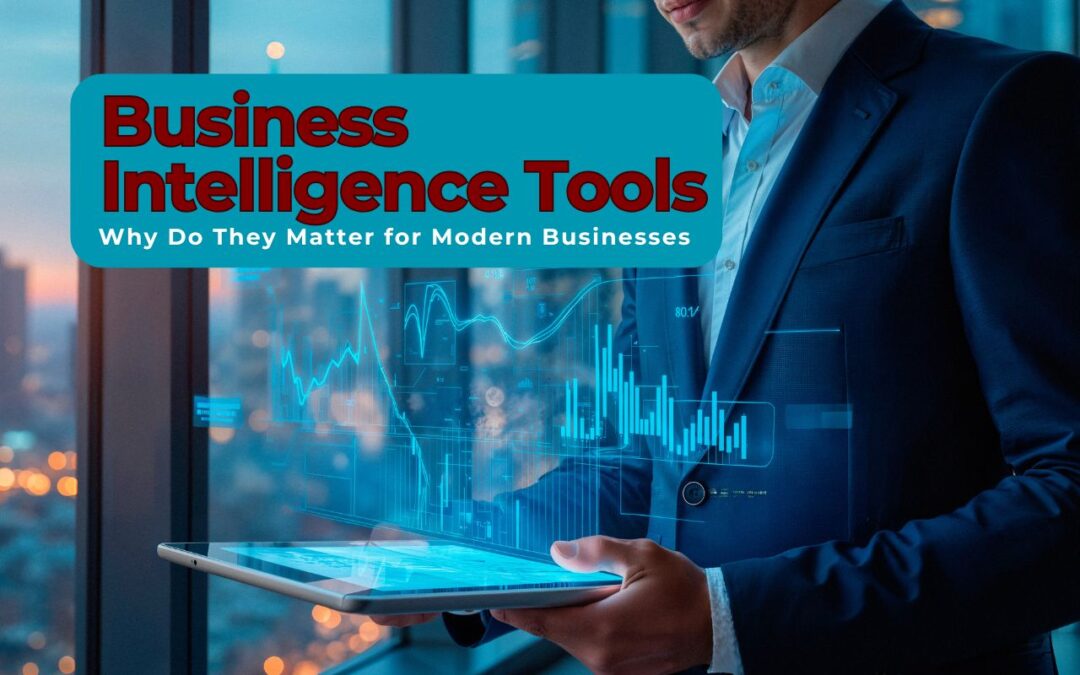In the digital age, the speed and complexity of business operations have reached new heights. Data flows into organizations from countless sources—websites, social media, customer service platforms, inventory systems, financial software, and more. With this explosion of data, modern businesses face a daunting challenge: How do they make sense of it all? How do they extract meaningful insights from raw numbers to make informed, strategic decisions?
That’s where Business Intelligence (BI) tools come into the picture. These tools act as a bridge between massive volumes of data and actionable business decisions. They help transform unstructured data into organized, digestible, and visual information. This blog will dive deep into what BI tools are, why they’re essential, and how they are changing the way companies operate today.
Understanding Business Intelligence
Before we explore the tools, it’s crucial to understand what Business Intelligence itself means. Business Intelligence refers to the set of technologies, processes, and practices that collect, integrate, analyze, and present business data. Its primary goal is to support better decision-making by providing timely and relevant information.
BI tools are the instruments that carry out this purpose. They gather and process data from various sources, organize it, and often visualize it using dashboards, graphs, and reports. Unlike traditional methods of sifting through spreadsheets or relying on intuition, BI provides a data-driven, evidence-based approach to business management.
Why Business Intelligence Tools Matter Today
In today’s hypercompetitive and fast-paced business environment, companies that fail to make data-driven decisions risk falling behind. Here’s why BI tools are more crucial than ever:
1. Data is Growing Exponentially
The world generates over 328.77 million terabytes of data each day (Statista, 2023). From emails and social interactions to e-commerce transactions and logistics, data is everywhere. BI tools help filter the noise, prioritize relevant data, and turn it into insights that drive real-world action.
2. Real-Time Decision Making is Critical
Gone are the days when businesses could afford to analyze data quarterly or even monthly. Decisions today must be made in real-time or near-real-time. Whether it’s optimizing a marketing campaign on the fly or adjusting supply chain logistics due to a global event, speed is vital. BI tools facilitate such responsiveness by constantly updating and presenting live data.
3. Enhanced Competitive Edge
Companies that use BI tools can spot trends, customer behaviors, market shifts, and internal inefficiencies before their competitors do. This proactive stance leads to a competitive advantage, allowing businesses to pivot strategies quickly and seize new opportunities.
4. Cost Reduction and Operational Efficiency
By identifying bottlenecks, inefficient processes, or underperforming products, BI tools help businesses streamline operations and reduce costs. Organizations often report a 10%–20% boost in efficiency after implementing data intelligence strategies.
5. Customer-Centric Strategies
Modern BI doesn’t just focus on internal operations—it also unlocks insights into customer preferences, buying behavior, satisfaction levels, and feedback trends. With this knowledge, businesses can design more personalized, targeted, and effective campaigns, increasing both customer satisfaction and loyalty.
How Business Intelligence Tools Work
BI tools follow a specific cycle to derive insights:
- Data Collection: They start by collecting data from multiple sources—internal systems (such as sales platforms, HR tools, or finance systems) and external ones (like social media or market databases).
- Data Cleaning and Integration: The collected data is often messy, redundant, or inconsistent. BI tools clean it up and standardize formats to create a single source of truth.
- Data Analysis: Through statistical methods, machine learning, and pattern recognition, these tools analyze the data to discover trends, anomalies, or predictions.
- Data Visualization: Complex insights are displayed in charts, dashboards, or graphs that are easy to understand and actionable.
Key Benefits of Using Business Intelligence Tools
1. Improved Decision Making
At the heart of BI is its ability to enable smarter decisions. Executives and managers no longer need to rely on intuition. They can back their decisions with data, reducing the risk of error.
2. Increased Accountability and Transparency
When metrics and performance indicators are visible to all departments, it creates a culture of transparency. Employees are more accountable, and departments can better collaborate with a unified vision.
3. Identifying Business Opportunities
By constantly scanning data for patterns and anomalies, BI tools often uncover hidden opportunities—whether it’s an untapped market segment or an upsell strategy that’s been overlooked.
4. Tracking KPIs in Real Time
Key Performance Indicators (KPIs) are critical to understanding business health. BI tools let teams monitor KPIs continuously, alerting them when metrics deviate from expected trends.
5. Better Forecasting and Planning
BI doesn’t just analyze the present—it also predicts the future. Forecasting models built into BI platforms can project sales, expenses, customer demand, and more, helping businesses plan strategically.
Real-World Use Cases of Business Intelligence Tools
BI tools are not industry-specific. They benefit nearly every sector. Here’s how:
- Retail: By analyzing customer preferences, seasonal buying patterns, and inventory turnover, retailers can optimize stock levels, improve sales strategies, and minimize waste.
- Healthcare: BI tools help hospitals monitor patient outcomes, reduce readmission rates, and manage resource allocation efficiently.
- Finance: Financial institutions use BI to detect fraud, manage risk, and create customer-centric banking experiences.
- Manufacturing: From supply chain visibility to production efficiency, BI enables manufacturers to stay agile and responsive.
- Education: Institutions use BI to track student performance, resource usage, and enrollment trends for better educational outcomes.
Challenges in Adopting Business Intelligence Tools
Despite their benefits, BI tools are not without challenges:
1. Data Quality Issues
If the underlying data is inaccurate, incomplete, or outdated, even the best BI systems can produce misleading insights. Organizations must commit to maintaining clean, consistent data.
2. Integration Complexity
Many businesses operate with legacy systems that don’t easily connect to modern BI platforms. Integration requires technical expertise and investment.
3. User Resistance
Introducing BI tools may require a cultural shift. Employees used to traditional methods might resist change unless proper training and change management are in place.
4. High Initial Investment
While BI tools offer long-term value, initial setup costs can be high, especially for small and medium-sized businesses. However, the ROI is typically worth the investment when used effectively.
Statistics Highlighting the Importance of BI
Let’s look at some compelling numbers that reinforce the value of BI in modern enterprises:
- According to a global survey by Dresner Advisory Services, over 60% of companies consider BI to be “critical” or “very important” to their operations.
- Organizations that use data-driven decision-making are 5% more productive and 6% more profitable than their competitors, according to a study by the MIT Center for Digital Business.
- A report from Forbes indicated that 87% of businesses believe BI will be essential for their success over the next few years.
- Data-driven companies are 23 times more likely to acquire customers, 6 times more likely to retain them, and 19 times more likely to be profitable, according to McKinsey Global Institute.
The Future of Business Intelligence
As technology evolves, so do BI tools. Future trends in BI include:
1. AI and Machine Learning Integration
Artificial Intelligence is making BI tools smarter. Instead of simply analyzing what happened, tools are starting to predict what will happen and even suggest the best course of action.
2. Natural Language Processing (NLP)
BI platforms are incorporating NLP, allowing users to ask questions in plain English and get visual data responses. This improves accessibility for non-technical users.
3. Mobile Business Intelligence
With the rise of remote work, mobile BI is gaining traction. Executives and employees can now access real-time dashboards on their phones or tablets, staying connected from anywhere.
4. Self-Service BI
Organizations are moving towards democratizing data. Self-service BI empowers all departments—not just IT—to generate their own insights, improving agility and innovation.
5. Data Governance and Security
As data breaches rise, BI platforms are also evolving to include stronger data governance policies, ensuring secure access and compliance with regulations.
Conclusion: Why BI Tools Are a Must for Modern Enterprises
In a world overflowing with data, having the right tools to extract meaning from it is no longer a luxury—it’s a necessity. Business Intelligence tools provide clarity, direction, and confidence in decision-making. They enable companies to act quickly, stay competitive, optimize resources, and anticipate market shifts.
No matter the size or industry, organizations that embrace BI tools set themselves up for long-term growth, adaptability, and resilience. As the data economy expands, the businesses that thrive will be those that turn information into impact—and BI tools are the foundation for that transformation.













